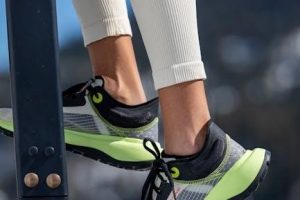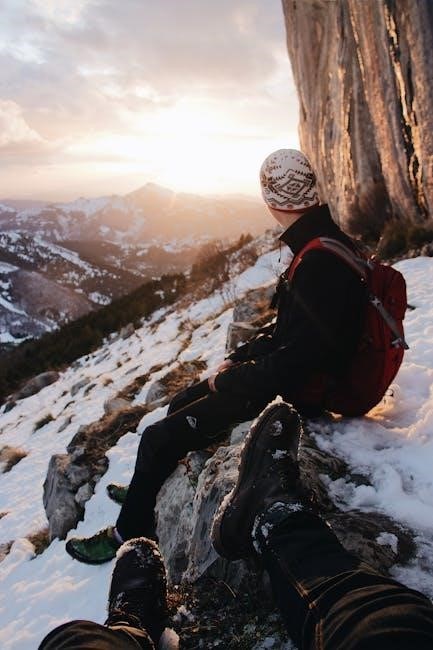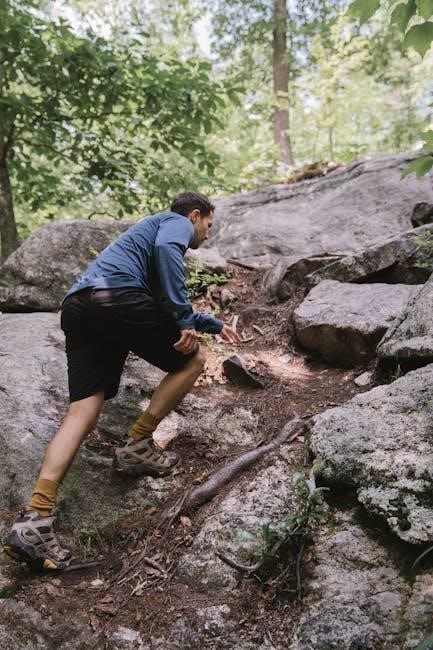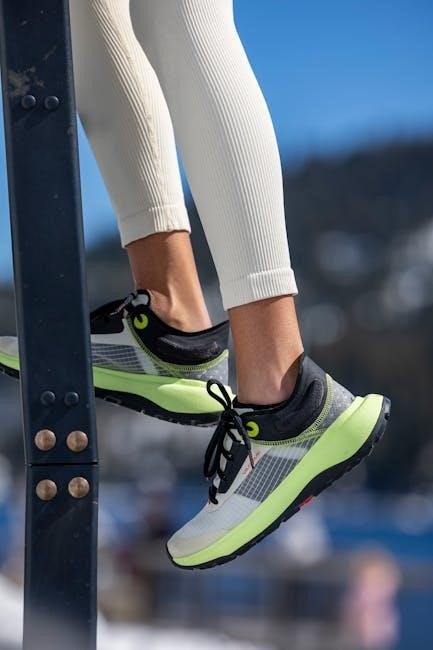climbing shoes size guide

Welcome to our comprehensive guide on climbing shoe sizing! Properly fitting climbing shoes are essential for comfort, performance, and injury prevention. This guide will help you understand key terminology, measure your feet accurately, and choose the right size for your climbing style. Whether you’re a beginner or an experienced climber, finding the perfect fit is crucial for unlocking your full potential on the rocks.
1.1 Welcome to Our Comprehensive Guide
Welcome to our detailed guide on climbing shoe sizing! Whether you’re a seasoned climber or just starting your adventure, finding the right shoe size is crucial for comfort, performance, and safety. Climbing shoes come in various styles and fits, catering to different climbing techniques and preferences. This guide will walk you through everything you need to know, from understanding key terminology to measuring your feet accurately. We’ll explore how to choose the perfect fit for your climbing style, avoid common mistakes, and break in your shoes for optimal comfort. By the end of this guide, you’ll be equipped with the knowledge to select climbing shoes that enhance your climbing experience and help you reach new heights.
1.2 Why Proper Shoe Size Matters in Climbing
Proper shoe size is critical in climbing as it directly impacts comfort, performance, and safety. Ill-fitting shoes can lead to discomfort, blisters, or even injuries, distracting you from your climb. A snug fit enhances precision and control, allowing better foot placement on holds. Conversely, overly tight shoes can cause pain and restrict circulation, while loose shoes may lead to poor grip and confidence loss. The right size ensures optimal support and responsiveness, tailored to your climbing style. Whether sport climbing or bouldering, proper sizing is essential for peak performance and enjoyment, making it a cornerstone of a successful climbing experience.

Understanding Key Terminology
Mastering key terms like “neutral fit,” “performance fit,” and “break-in period” is essential for selecting the right climbing shoes. These terms help you understand shoe design and functionality, ensuring you make informed decisions tailored to your climbing needs and preferences.
2.1 Neutral Fit
A neutral fit in climbing shoes offers a relaxed, comfortable design, ideal for extended wear. These shoes feature a roomier toe box and a flatter sole, promoting better blood circulation and reducing fatigue. Neutral fit shoes are perfect for all-day climbing adventures and are often recommended for beginners. They provide adequate grip on holds while prioritizing comfort, making them versatile for various climbing styles. Popular models like the La Sportiva Tarantula and Five Ten Acopa exemplify this category, balancing comfort with performance. Choose neutral fit shoes for a stress-free climbing experience, especially during long sessions or for those prioritizing ease of use.
2.2 Performance Fit
A performance fit in climbing shoes is designed for maximum precision and responsiveness, ideal for advanced climbers tackling steep terrains. These shoes feature a snug, aggressive downturned shape, allowing for optimal power transfer and sensitivity on small holds. Performance fit shoes are tailored for sport climbing and bouldering, where foot placement is critical. They prioritize support and stability, enabling climbers to push their limits on challenging routes. Popular models like the Scarpa Drago and Evolv Shaman exemplify this category, offering unparalleled performance. Choose performance fit shoes for a tighter, more responsive experience, perfect for climbers seeking to maximize their technical abilities and tackle demanding climbs.
2.3 Shoe Width and Comfort
Shoe width plays a crucial role in comfort and performance. Climbing shoes come in various widths, from narrow to wide, catering to different foot shapes. A proper width ensures your foot sits comfortably without excessive pressure or movement. For narrow feet, a snug width enhances precision, while wider feet benefit from a roomier toe box. Comfort is key for extended climbs; ill-fitting width can lead to discomfort or distraction. Consider brands offering multiple widths to find your ideal fit. Proper width and comfort allow you to focus on your climbing, ensuring a better overall experience and performance on the rock.
2.4 Break-In Period
The break-in period is essential for climbing shoes, especially those made of leather, as they mold to your feet over time. Unlined leather shoes often require a longer break-in, while synthetic materials may need less. During this process, shoes adapt to your foot shape, providing a more personalized fit. It’s important to be patient, as rushing the break-in can cause discomfort. For unlined leather shoes, stretching can take several climbs, but they offer long-term comfort. Synthetic shoes, while quicker to break in, may not mold as extensively. Proper break-in ensures optimal performance and comfort, making the initial effort worthwhile for your climbing sessions.
The Importance of Proper Sizing
Proper sizing ensures comfort, enhances performance, and prevents injuries. Well-fitting shoes allow precise footwork and support, making your climbing experience safer and more enjoyable overall.
3.1 Comfort During Climbing
Comfort during climbing is crucial for a positive experience. Properly sized shoes prevent blisters and hotspots, allowing you to focus on your route. A snug fit ensures your feet stay secure, reducing fatigue and discomfort during long climbs. Ill-fitting shoes can cause pain and distract you from your performance. Prioritizing comfort means you can climb longer and more confidently, making every ascent more enjoyable. Ensure your shoes are not too tight or too loose to maintain optimal comfort and support throughout your climbing sessions.
3.2 Enhanced Performance
Properly sized climbing shoes significantly enhance performance by providing precision and responsiveness. A snug fit allows your feet to feel the rock better, enabling precise foot placement and control. This is especially crucial for sport climbing and bouldering, where small holds require maximum sensitivity. A well-fitting shoe ensures optimal power transfer, helping you tackle challenging routes with confidence. For sport climbing, a slightly tighter fit improves grip on steep terrain, while a more relaxed fit suits all-day comfort. Balancing performance and comfort ensures you can climb efficiently without distractions, making every move more deliberate and effective. The right size lets you connect with the rock seamlessly, boosting overall climbing performance.
3.3 Injury Prevention
Properly fitting climbing shoes play a crucial role in injury prevention. Ill-fitting shoes can lead to discomfort, blisters, or even long-term foot issues. Shoes that are too tight can restrict blood flow, causing pain and numbness, while overly loose shoes may cause feet to slide, leading to poor foot placement and potential accidents. A snug yet comfortable fit ensures stability and support, reducing the risk of injuries during climbs. By prioritizing proper sizing, climbers can minimize discomfort and maintain healthy feet, allowing for more enjoyable and injury-free climbing experiences. Correct sizing is essential for protecting your feet and ensuring long-term climbing health.

Measuring Your Feet Accurately
Stand on a piece of paper, trace your foot outline, and measure the longest part from heel to toe. Use a ruler to determine length and width, then compare to a shoe size chart for precise sizing.
4.1 How to Measure Foot Length
To measure foot length accurately, stand on a flat surface with your weight evenly distributed. Place a piece of paper under your foot and trace the outline of your foot, ensuring the pen is held perpendicular to the paper. Measure the longest distance from the back of the heel to the tip of the longest toe using a ruler or measuring tape. Record this measurement and compare it to the brand’s sizing chart to determine your ideal shoe size. This method ensures precision and helps find the best fit for your climbing shoes.
4.2 How to Measure Foot Width
To measure foot width, stand on a flat surface with your weight evenly distributed. Use a flexible measuring tape or a ruler to measure the widest part of your foot, typically across the metatarsals. Place the measuring tape or ruler perpendicular to your foot, ensuring it is flat and not angled. Record the measurement in centimeters or inches. This width, combined with your foot length, helps determine the best fit for your climbing shoes. Comparing this measurement to brand-specific sizing charts ensures a comfortable and precise fit, especially in the toe box area, which is crucial for climbing performance and comfort.
4.3 Brand-Specific Sizing Charts
Brand-specific sizing charts are crucial for ensuring the perfect fit. Each manufacturer uses its own last, which determines the shoe’s shape and size. For example, La Sportiva, Five Ten, and Black Diamond have distinct sizing patterns. La Sportiva tends to run slightly smaller, so you might need a half size larger than your street shoe. Five Ten offers a more relaxed fit, aligning closely with street shoe sizes. Black Diamond sizing is generally consistent but may vary by model. Always refer to the brand’s chart and consider trying on multiple styles to find your ideal fit, as sizing can differ significantly between brands and even within the same brand’s product line.

Trying On Climbing Shoes
Trying on climbing shoes is essential to ensure a proper fit. Walk around, flex your feet, and mimic climbing movements to assess comfort and performance. This step helps you determine if the shoes meet your needs for various climbing activities, ensuring both support and mobility.
5.1 Best Time to Try Them On
The best time to try on climbing shoes is later in the day, as feet tend to swell throughout the morning and afternoon. This ensures a more accurate fit, as your feet will be at their largest. Bring the same type of socks you plan to climb in to gauge comfort and support. Trying on multiple brands and models allows you to compare fits and identify the most comfortable option for your foot shape. Spending a few minutes walking around and flexing your feet helps assess how the shoes feel during movement, ensuring they meet your needs for both comfort and performance.
5.2 Factors to Consider During Fitting
During the fitting process, ensure the shoes feel snug but not painfully tight. Your heel should sit securely with minimal movement, and the arch support should feel natural. Pay attention to the toe box—your toes should lightly touch the end without curling uncomfortably. If you plan to wear thick socks, bring them along to gauge the fit. Consider the break-in period, as some materials, like leather, will stretch over time. Lastly, try multiple brands and models, as sizing and shapes vary, to find the best match for your foot shape and climbing style. This ensures optimal comfort and performance.
5.3 Importance of Testing the Fit
Testing the fit of climbing shoes is crucial for ensuring comfort and performance. Walk around the store, flex your feet, and mimic climbing movements to assess how the shoes feel. Pay attention to pressure points or hotspots, as these can indicate improper fit. If possible, try the shoes on later in the day, as feet tend to swell slightly. Properly fitted shoes should allow your toes to lightly touch the end without curling, and the heel should stay secure. This testing phase helps prevent discomfort during long climbs and ensures you can maintain precision and control on the rock, enhancing your overall climbing experience.
Types of Climbing Shoes
Climbing shoes come in two main types: neutral fit for comfort and versatility, ideal for beginners, and performance fit for precision on steep terrain, suiting advanced climbers.
6.1 Neutral Fit Shoes
Neutral fit shoes are designed for comfort and versatility, making them ideal for beginners or climbers seeking all-day wear. These shoes feature a roomier toe box and a flatter sole, allowing for better blood circulation and reduced pressure on the feet. They are perfect for long climbing sessions or routes that require endurance rather than intense precision. Popular models like the La Sportiva Tarantula and Five Ten Acopa prioritize comfort while still offering reliable grip on holds. Neutral fit shoes are a great choice for climbers who value ease of use and extended wearability without compromising performance.
6.2 Performance Fit Shoes
Performance fit shoes are engineered for maximum precision and responsiveness, ideal for advanced climbers tackling steep or technical routes. These shoes typically feature an aggressive, downturned design that enhances power transfer and sensitivity on small holds. The snug fit allows for better control, making them perfect for sport climbing and bouldering. Popular models like the Scarpa Drago and Evolv Shaman exemplify this category, offering superior performance on challenging terrains. While they may sacrifice some comfort for tightness, performance fit shoes are essential for climbers seeking optimal grip and precision in demanding situations.
Climbing Style and Shoe Choice
Your climbing style significantly influences shoe choice, with sport climbing requiring a snug fit for precision and bouldering often benefiting from a tighter fit for better control.
7.1 Sport Climbing Considerations
Sport climbing demands precision and grip on varied terrains. Opt for a snug fit to enhance control and sensitivity on holds. Shoes like the La Sportiva Theory, with a downturned design, excel in steep routes by providing power and sensitivity. Ensure your toes are slightly curled but not cramped, allowing for responsiveness. A tight yet comfortable fit around the toe box is crucial for support during vertical and overhanging climbs. Consider models offering a balance of comfort and performance, ensuring your shoes adapt to the route’s demands while maintaining foot health during long climbs.
7.2 Bouldering Fit Recommendations
Bouldering requires a snug, responsive fit for maximum control on dynamic movements. Opt for a tighter fit compared to sport climbing, as bouldering involves shorter, powerful moves. Shoes like the Black Diamond Momentum are ideal, offering a close fit and comfort. A snug fit ensures better grip and precision during explosive movements. However, avoid overly tight shoes that cause discomfort. Consider models with a downturned shape for enhanced power transfer. When sizing for bouldering, prioritize a balance of tightness and comfort to maintain sensitivity and control. This ensures optimal performance on short, intense climbs.
Brand Differences in Sizing
Brands like La Sportiva, Five Ten, and Black Diamond vary in sizing approaches, with some recommending street shoe size as a base and others suggesting tweaks for performance or comfort.
8.1 La Sportiva Sizing
La Sportiva sizing varies slightly depending on the shoe model and intended use. For beginners, they recommend choosing a size 38, which is half a size larger than their standard chart suggests, ensuring a comfortable yet snug fit. Intermediate climbers often find size 37.5 to be ideal, aligning perfectly with the brand’s sizing recommendations. Performance-oriented climbers may opt for a half size smaller than their street shoe size for a tighter, more responsive fit. La Sportiva’s women’s shoes are designed with a slightly different shape and less rigidity, catering to the female foot’s unique needs for enhanced comfort and flexibility.
- Beginners: Size 38 for comfort and snugness.
- Intermediate: Size 37.5 as per recommendations.
- Performance: Half size smaller for responsiveness.
- Women’s shoes: Tailored shape and flexibility.
8.2 Five Ten Sizing
Five Ten sizing is known for its consistency and comfort across various models. Climbers often find their street shoe size translates well to Five Ten sizes, especially for neutral fit options. However, for performance models like the Hiangle or Team, a snug fit is crucial for precision, suggesting a half size smaller than street shoes. The brand’s patented Stealth rubber and ergonomic design ensure a secure fit without sacrificing comfort. For longer sessions, Five Ten shoes remain comfortable, making them ideal for endurance climbing. Whether sport climbing or bouldering, Five Ten offers a reliable fit that balances performance and comfort.
- Neutral fit: Match street shoe size.
- Performance models: Half size smaller.
- Stealth rubber ensures secure fit.
- Suitable for endurance climbing.
8.3 Black Diamond Sizing
Black Diamond sizing is straightforward, with most climbers finding their street shoe size translates well to their climbing shoes. For a snug, performance-oriented fit, advanced climbers often opt for half a size smaller than their street shoe size. Black Diamond shoes are known for their comfort and responsiveness, making them versatile for both sport climbing and bouldering. The brand’s sizing remains consistent across models, ensuring reliability. Whether you prefer a neutral or performance fit, Black Diamond offers a secure and comfortable option tailored to your climbing needs.
- Start with your street shoe size as a base.
- Advanced climbers: Half size smaller for performance.
- Consistent sizing across all models.
- Versatile for sport climbing and bouldering.

Advanced Tips for Choosing the Right Size
For expert climbers, consider foot shape, climbing style, and shoe flexibility. Try multiple brands to find your best fit, and test shoes during actual climbing sessions.
- Foot shape significantly impacts shoe fit.
- Test shoes during climbing for accuracy.
- Consider shoe flexibility for specific routes.
9.1 Trying Multiple Brands
Trying multiple climbing shoe brands is crucial due to varying fits and sizing. Each brand uses a unique last, affecting how shoes conform to your feet. For example, La Sportiva may recommend a half-size larger for comfort, while Five Ten suggests sticking close to your street shoe size. Black Diamond offers straightforward sizing but may require adjustments for performance fits. Testing different brands helps you identify which models align best with your foot shape and climbing style. This step ensures you find the optimal balance of comfort, support, and precision for your adventures.
- Compare fits across brands to find your best match.
- Consider how each brand’s sizing aligns with your street shoe size.
- Test shoes during actual climbing to assess performance.
9.2 Considering Personal Comfort
Personal comfort is a critical factor when choosing climbing shoes. While performance is important, shoes that cause pain or discomfort can hinder your climbing experience. Consider your foot shape, arch support needs, and whether you prefer a snug or roomier fit. For long sessions, comfort-focused shoes with breathable materials are ideal. However, for high-performance climbs, a tighter fit may be necessary. It’s essential to balance comfort with the demands of your climbing style. Prioritize shoes that feel good during both casual and intense climbing to ensure a positive and effective experience on the rock.
- Assess your foot shape and arch support needs.
- Choose breathable materials for extended wear.
- Balance comfort with performance requirements.
9.3 The Break-In Process
The break-in process is crucial for climbing shoes, especially unlined leather models, as they need time to mold to your foot shape. Initially, the shoes may feel tight or stiff, but with patience, they will adapt, offering a personalized fit. Wearing them for short periods and gradually increasing usage helps ease the break-in. Proper break-in ensures comfort during long climbs and improves performance by allowing the shoe to respond better to foot movements. Avoid rushing this process, as it directly impacts your climbing experience. A well-broken-in shoe provides optimal comfort and support, enhancing your overall performance on the rock.
- Wear shoes for short periods initially.
- Gradually increase wear time.
- Allow the shoe to mold to your foot shape.

Common Mistakes to Avoid
Avoid relying solely on street shoe size and not trying shoes before buying. These mistakes can lead to poor fit, discomfort, and reduced performance during climbs.
- Relying only on street shoe size.
- Not trying shoes before purchasing.
10.1 Relying Solely on Street Shoe Size
Relying only on your street shoe size is a common mistake when sizing climbing shoes. Climbing shoes often fit differently due to their specialized design. Brands like La Sportiva, Five Ten, and Black Diamond may size their shoes uniquely, so your street size might not translate directly. For example, a climber who wears a size 9 in street shoes might need a size 8;5 in La Sportiva climbing shoes. Ignoring brand-specific sizing charts can lead to poor fit, discomfort, and reduced performance. Always try shoes on and consult brand sizing guides to ensure the best fit for your climbing needs.
10.2 Not Trying Before Buying
Not trying climbing shoes before buying is a mistake that can lead to poor fit and discomfort. Climbing shoes often fit differently than street shoes, and sizes can vary significantly between brands. Without trying them on, you risk ending up with shoes that are too tight or too loose, which can hinder performance and cause pain. Even if you think you know your size, factors like shoe shape and brand-specific sizing can affect the fit. Always try shoes on, walk around, and mimic climbing movements to ensure comfort and support. This step is crucial for avoiding dissatisfaction and ensuring your shoes meet your climbing needs effectively.
Finding the perfect climbing shoe fit is key to unlocking your climbing potential. Take your time, prioritize comfort, and balance performance needs to ensure confidence on every climb.
11.1 Final Thoughts on Shoe Sizing
Proper climbing shoe sizing is a balance of comfort and performance. A snug fit enhances precision and control, while avoiding pain ensures long-term comfort. Remember, sizing varies between brands, so try multiple pairs. Prioritize your climbing style—sport climbers may opt for a tighter fit, while bouldering demands even more precision. Consider your foot shape and personal comfort, and don’t hesitate to size up for all-day wear. Investing time in finding the right fit will elevate your climbing experience, allowing you to focus on the route ahead with confidence and control.
11.2 Encouragement for Climbers
Embark on your climbing journey with confidence by prioritizing proper shoe sizing. Whether you’re tackling boulders or sport routes, the right fit empowers you to perform at your best. Remember, climbing is about progression, not perfection—every step forward is a victory. Invest in shoes that support your unique needs, and don’t be afraid to experiment until you find your ideal pair. With the right fit, you’ll feel more connected to the rock, ready to push limits and enjoy the adventure. Happy climbing, and let your shoes be the foundation that helps you reach new heights!